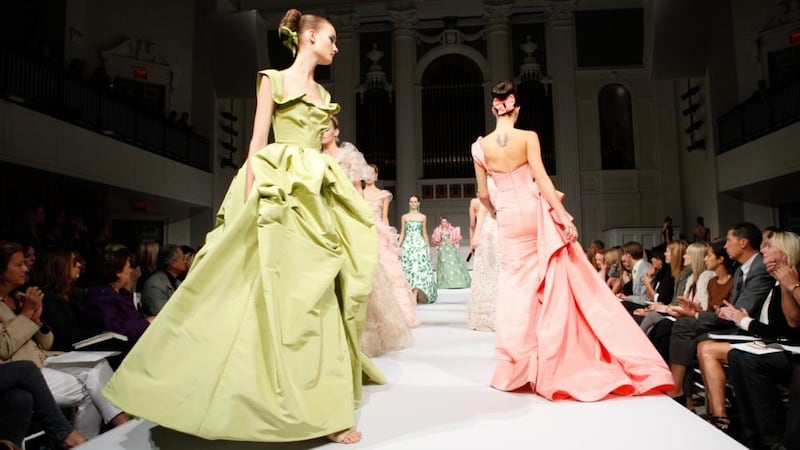The fashion designer Oscar de la Renta, who has died aged 82, arrived in New York in 1963 with letters of introduction to the editor-in-chief of Vogue, Diana Vreeland, the Condé Nast magazines supremo Alex Liberman, and John Fairchild, whose family owned Women's Wear Daily.
Within a day, he was offered a job designing couture for Elizabeth Arden’s boutique on Fifth Avenue – she asked his price and he answered, preposterously, $700 a week. He got it, earned it, and charmed his employer out of ill-humour by letting her win at cards.
He stuck to the same approach throughout his long career: talent, daily application, perfect timing, and a suavity that took the anxious edge off big-occasion dressing. In his last 15 years, he became the safest pair of hands for women exposed to the eyes of the world on red carpets or bridal aisles. Most recently, Amal Alamuddin married George Clooney in a fussless, timeless Oscar de la Renta gown in September.

Born in Santo Domingo in the Dominican Republic, he was the youngest child of a well-off family; his six sisters backed him when he pleaded with his mother to study art in Madrid rather than join his father's insurance business.
He was given his wish after his mother’s death, and sailed for Spain, aged 19; the sisters secretly supplemented his allowance from his father, and he spent most of the money on a wardrobe of suits by the tailor Luis Lopez (whose firm he ever after patronised).
He understood the disciplined ease of fine tailoring, and that clothes could defend him from prejudice – he always wore a tie, because “I have this complex that if I walk into a place wearing a colourful shirt, someone will stop me and say ‘I’m sorry, but the Latin band comes through the other door.’”
Cover of ‘Life’
He earned extra money by sketching clothes for newspapers or couture clients; some sketches were seen by the wife of the US ambassador in Spain, Francesca Lodge. She asked him to design a debutante dress for her daughter in 1956, which made a cover story in
Life
magazine.
He was given a job – more sketches for clients – in Cristóbal Balenciaga's Madrid branch. Later he moved to Paris to work for Christian Dior. Then Antonio del Castillo, who designed for Lanvin, hired him as an assistant and later encouraged the crucial move to New York.
The ready-to-wear garment trade was changing in Manhattan even as he arrived. Manufacturers and department stores had long sewn their own brand labels on garments made by freelances – as de la Renta said: “The designer was the little guy in the back.”
Spirit of the 1960s
He credited Fairchild and
Women’s Wear Daily
with promoting the identity of the creator, though it was also the philosophy of the 1960s, in which creativity and image mattered as much as money or class. “We were all mostly good-looking guys who brought something to social life once we were no longer hidden in the workrooms,” de la Renta said.
His own company developed, from 1965, out of a partnership with an old-style Seventh Avenue firm, and that development depended both on the new professional women buying their own clothes with their own earned money, and de la Renta’s agreeable New York social life.
In 1967, he became the third husband of a former editor of French Vogue, Françoise de Langlade, and, as he observed, it was cheap enough then in Manhattan for those on a creative's income to live an enviable life, mixing at art and charity events, and in their own homes, with people with serious inherited wealth. Jackie Kennedy, Babe Paley and Gloria Guinness liked him and his clothes equally.
As Cathy Horyn of the New York Times shrewdly noted, the de la Rentas were the subject of a famous 1980 article in the paper's magazine that marked the precise moment at which the people who created garments in New York were visibly seen to be part of a social elite – a long way to have climbed from the back rooms of the garment district in barely 20 years.
He then got to dine with, and dress, the US first ladies Nancy Reagan, Laura Bush and Hillary Clinton - the unlikely venue for his recent first retrospective was the Clinton Presidential Library in Little Rock, Arkansas (de la Renta was a staunch Democratic supporter). After much sharp teasing from him over her un-American choices for state events, Michelle Obama finally wore one of his designs earlier this month. From the mid-90s, red carpet appearances displaced the old show catwalk as the place where couture fashion was displayed.
De la Renta had a good understanding of the demands through half a century of partygoing, and was unusually thoughtful towards the women he dressed: no woman was ever embarrassed by wearing Oscar de la Renta to the Oscars, and among those who did were Amy Adams, Penelope Cruz and Sarah Jessica Parker.
His business benefited, more than doubling in the last decade of his life to $150 million in sales, with an affordable diffusion line and other everyday garments filling in behind the special event gowns.
De la Renta retained dual US/Dominican nationality and had two sunny, and usually celebrity-filled, homes there. Françoise died in 1983. In 1989 he married Annette Engelhard. She, and stepchildren from both marriages, survive him.








